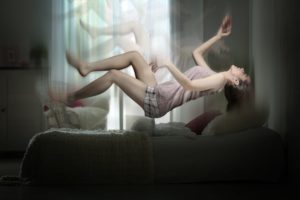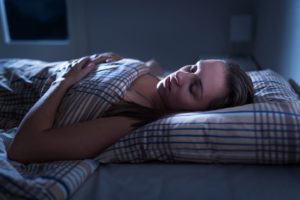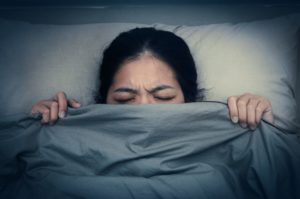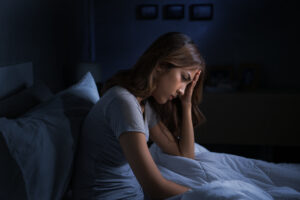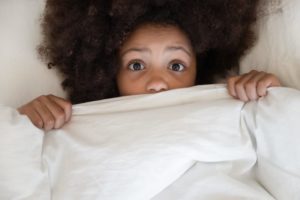When you buy through our links, we may earn a commission. Products or services may be offered by an affiliated entity. Learn more.
Night Terrors (Sleep Terrors)
- Definition: Night terrors are episodes of intense fear or panic that occur during deep sleep, often causing screaming or thrashing.
- Symptoms: Common symptoms include sudden awakening, rapid heartbeat, sweating, and difficulty calming down, with little or no memory of the event.
- Causes: They are linked to disrupted sleep, stress, fever, certain medications, or underlying sleep disorders.
- Treatment: Treatment focuses on improving sleep habits, managing stress, and, in severe cases, using therapy or medication.
Though not harmful in themselves, night terrors are disruptive sleep episodes that can be distressing for both the sleeper and their loved ones. Studies estimate that 30% to 40% of young children experience night terrors at some point. And though night terrors become less common after age 10, they can also occur in adults.
Learn what causes night terrors, how they differ from nightmares, how to stop night terrors, and when to see a doctor—for either yourself, your child, or a loved one.
What Are Night Terrors?
Night terrors, also called sleep terrors, make a person wake up from sleep in a state of panic or terror. Night terrors are a type of parasomnia, a category of sleep disorders that involve unusual movements or behaviors during sleep.
Night terrors occur during non-rapid eye movement (NREM) sleep. NREM sleep encompasses both light and deep sleep, but not REM sleep, the stage most associated with vivid dreaming. Since people spend more time in NREM sleep earlier in the night, night terrors are more common during the first third of a night’s sleep. This is especially true for children.
Night Terrors vs. Nightmares
Night terrors and nightmares differ in that only from nightmares does a person wake up feeling scared. Nightmares involve the recall of vivid, frightening dreams. Night terrors involve waking, in a state of apparent fear, but there’s no remembered dream, and the sleeper may not recall waking up.
Night terrors happen during NREM sleep stages, while nightmares generally happen during REM sleep. Because of this difference, night terrors are most common in the first third of the night, and nightmares are most common in the second half of the night as the duration of REM periods lengthen.
| Feature | Night Terrors | Nightmares |
|---|---|---|
| When They Occur | Early in the night, during non-REM deep sleep (stages 3 and 4) | Later in the night, during REM sleep |
| Behavior During Episode | May sit up, scream, thrash, or run | Usually remain still in bed; may wake up crying or fearful |
| Awakening | Difficult or impossible to fully awaken | Person usually wakes up easily |
| Recall | Little to no memory of the episode | Clear recall of the dream content |
| Duration | 10 to 40 minutes | A few minutes, sometimes longer |
| Who’s Affected | More common in children, less common in adults | Common in both children and adults |
| Underlying Triggers | Often linked to stress, fever, sleep deprivation, or genetics | Often related to stress, trauma, or anxiety |
Is Your Troubled Sleep a Health Risk?
A variety of issues can cause problems sleeping. Answer three questions to understand if it’s a concern you should worry about.
Night Terror Symptoms
During a night terror, a person may suddenly sit up, jump out of bed, or scream. A person experiencing a night terror often displays other signs of fear, such as sweating, a rapid heart rate, and dilated pupils.
Common symptoms of night terrors include:
- Sitting up abruptly or jumping out of bed
- Screaming, crying, or vocal expressions of fear
- Sweating, rapid heartbeat, and dilated pupils
- Thrashing, kicking, or other sudden movements
- Difficulty being comforted or woken up
- No memory of the episode afterward
A night terror can last between 10 and 40 minutes. Usually, others cannot calm down a person having a night terror. After the night terror ends, the person who experienced it often doesn’t remember anything.
What Causes Night Terrors?
Night terrors are thought to occur when someone partially wakes up, but remains in a mixed state of consciousness between sleep and wakefulness. For this reason, night terrors may also be called an arousal parasomnia or a disorder of arousal. No clear cause of night terrors has been determined yet, but multiple factors make a person more likely to experience them.
- Age: Young children are most likely to experience night terrors. They become less common with age, and most people stop having them by adolescence.
- Genetics: Multiple studies suggest that parasomnias can run in families.
- Sleep disorders: Sleep disorders that cause a person to briefly wake up throughout the night have been linked to night terrors. These include obstructive sleep apnea and periodic limb movement disorder, a condition that may be correlated with restless legs syndrome.
- Anxiety: Although night terrors are common among children, they’ve been linked to separation anxiety in some children. Adults with post-traumatic stress disorder (PTSD) or another mood disorder may be more likely to have night terrors.
- Sleep deprivation: After being deprived of sleep, a person spends more time in a deep sleep stage the next time they sleep. Since night terrors happen more from that stage, they may become more likely after sleep deprivation.
- Fever: Similarly, a fever can cause an increase in deep sleep, which may then increase the chance of night terrors.
Night Terrors in Children
Night terrors occur commonly in young children, but most stop experiencing them once they reach adolescence. A child may have night terrors a few times a month or a few times a week.
Although witnessing night terrors can be upsetting for parents and caregivers, the children having them usually don’t remember that they occurred. During a night terror, a child cannot be calmed down by others, and attempts to calm them may upset them more. Children who have night terrors may also be more likely to begin sleepwalking.
Night Terrors in Adults
Up to 3% of adults experience night terrors. Night terrors among adults may be more dramatic than those in kids. An adult having a night terror may let out a piercing scream or move out of bed in a violent way. Night terrors in adults can lead to injury in some cases.
Night terrors can indicate an underlying problem in adults. Adults who have night terrors may also have post-traumatic stress disorder (PTSD), or another anxiety disorder or mental health issue.
Diagnosing Night Terrors
Night terrors are usually diagnosed based on a description of the episodes rather than a medical test. A health care provider will ask about the person’s sleep history, family history of sleep disorders, and any underlying conditions that might contribute to disturbed sleep. Parents of children with night terrors may be asked to keep a sleep diary or record episodes to provide more detail.
In most cases, further testing isn’t necessary, but a doctor may recommend a sleep study (polysomnography) if symptoms are severe, frequent, or difficult to distinguish from other sleep disorders such as seizures or sleepwalking. This overnight test records brain activity, breathing, heart rate, and muscle movements to help confirm the diagnosis and rule out other conditions.
Night Terrors Treatment
There’s no single cure for night terrors, but treatment focuses on reducing their frequency and impact. For many children, night terrors are temporary and fade as they grow older, so reassurance and creating a safe sleep environment are often the main steps.
Parents can make sure their child’s bedroom is free of hazards, and in some cases, gently guiding them back to bed without waking them may help. For example, you could lower the mattress to the floor, set padding on the floor near the bed, keep potentially dangerous items in a separate room, lock doors and windows, and set up an alarm to indicate attempts to leave the room.
For both children and adults, good sleep hygiene—such as consistent bedtimes, a calming bedtime routine, and enough total sleep—can reduce episodes. Addressing potential triggers like stress, sleep deprivation, or underlying medical conditions is also important.
- Get adequate sleep: Since a lack of sleep can potentially trigger night terrors the next time a person sleeps, avoiding sleep deprivation is important. It can be important to keep a regular sleep-wake schedule with a consistent wake time and allow sufficient hours of rest to meet an individual’s sleep needs.
- Avoid triggering substances: Experts advise people with night terrors avoid consuming alcohol and caffeine, as both may increase the likelihood of night terrors. Certain medications may also trigger night terrors as a side effect and should be avoided.
- Treat underlying disorders: Disorders such as obstructive sleep apnea and periodic limb movement disorder can trigger night terrors by causing brief awakenings. As a result, treating these disorders may stop or reduce a person’s night terror episodes.
- Avoid sleep disruptions: Since night terrors tend to occur during brief awakenings, eliminating sleep disruptions may help. For example, pets can be kept out of the bedroom and efforts can be taken to block potentially disruptive noises.
If night terrors are frequent, severe, or disruptive to the household, a doctor may suggest behavioral strategies, such as scheduled awakenings before the time night terrors usually occur. In rare cases, medication may be considered, but this is typically reserved for situations where other approaches have not been effective.
When to See a Doctor
Occasional night terrors are usually not cause for concern, especially in young children who often outgrow them. However, it’s a good idea to consult a doctor if the episodes are frequent, prolonged, or especially intense, or if they cause injury to the sleeper or others. Parents should also seek medical advice if night terrors lead to significant daytime sleepiness, problems at school, or behavioral changes.
For adults, night terrors are less common and may signal an underlying sleep disorder or medical condition. In these cases, a doctor can help determine whether further evaluation, such as a sleep study, is needed.
Frequently Asked Questions
When do night terrors start?
Night terrors most often begin in early childhood, typically between ages 3 and 7. They can occur earlier or later, but they are less common in infants and usually decrease with age.
Are night terrors in toddlers a sign of mental illness?
No. Night terrors are not considered a sign of mental illness. They are usually related to the brain’s transition between sleep stages and often resolve as a child grows.
Are night terrors genetic?
There is evidence that night terrors can run in families. Children whose parents experienced night terrors or sleepwalking may be more likely to have them.
Can infants get night terrors?
True night terrors are very rare in infants. Babies may cry or move during sleep, but most experts believe night terrors do not typically occur before age 18 months.
Should you wake your child during night terrors?
Experts advise against trying to wake up your child during a night terror. Trying to wake them up, restrain them, or even calm them may backfire and cause them to be more upset. Instead, try to gently guide them back to bed while speaking slowly and quietly.
How long do night terrors last?
A night terror episode usually lasts 10 to 40 minutes. During this time, the person may appear awake but is difficult to comfort. Afterward, they typically fall back asleep and don’t remember the event.

Still have questions? Ask our community!
Join our Sleep Care Community — a trusted hub of sleep health professionals, product specialists, and people just like you. Whether you need expert sleep advice for your insomnia or you’re searching for the perfect mattress, we’ve got you covered. Get personalized guidance from the experts who know sleep best.
References
6 Sources
-
Patient education: Night terrors, confusional arousals, and nightmares in children (The Basics). (2024, February 28). UpToDate.
https://www.uptodate.com/contents/night-terrors-confusional-arousals-and-nightmares-in-children-the-basics -
Van Horn, N. & Street, M. (2023, May 29). Night Terrors. StatPearls.
https://www.ncbi.nlm.nih.gov/books/NBK493222/ -
Zak, R. & Karippot, A. (2024, January). Nightmares and nightmare disorder in adults. In A. Eichler & M. Friedman (Ed.). UpToDate.
https://www.uptodate.com/contents/nightmares-and-nightmare-disorder-in-adults -
Morse, A. & Kotagal, S. (2024, January). Parasomnias of childhood, including sleepwalking. In R. Chervin & A. Hoppin (Ed). UptoDate.
https://www.uptodate.com/contents/parasomnias-of-childhood-including-sleepwalking -
Foldvary-Schaefer, N. (2024, January). Disorders of arousal from non-rapid eye movement sleep in adults. In A. Avidan & A. Eichler (Ed.). UpToDate.
https://www.uptodate.com/contents/disorders-of-arousal-from-non-rapid-eye-movement-sleep-in-adults -
Leung, A. K. C., Leung, A. A. M., Wong, A. H. C., & Hon, K. L. (2020). Sleep Terrors: An Updated Review. Current pediatric reviews, 16(3), 176–182.
https://pubmed.ncbi.nlm.nih.gov/31612833/








